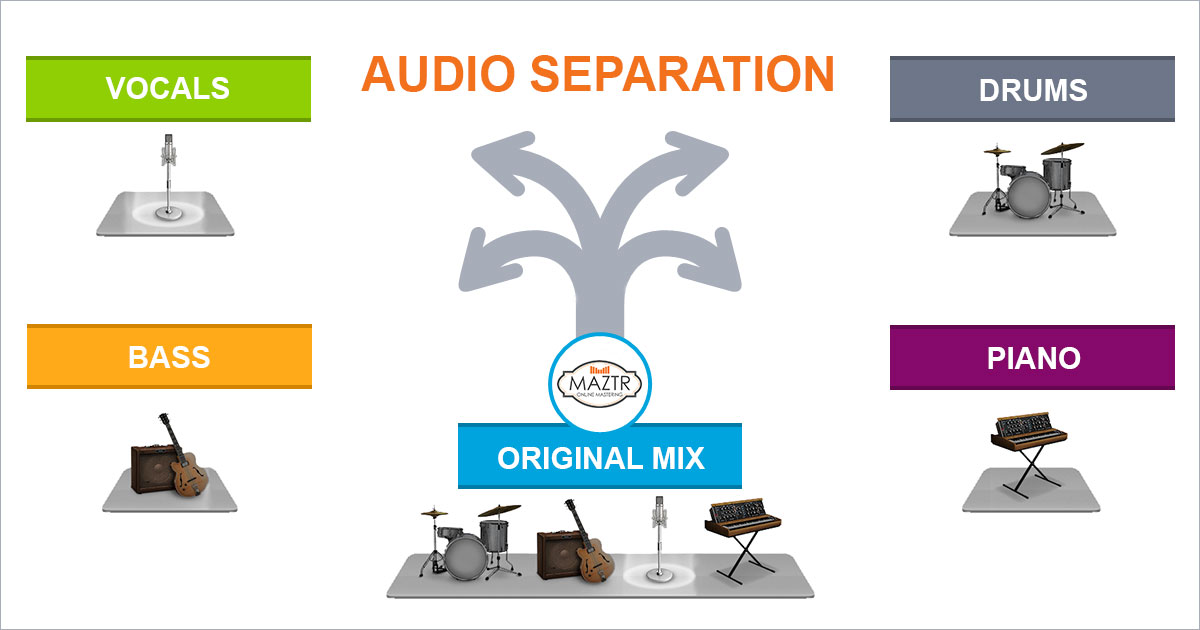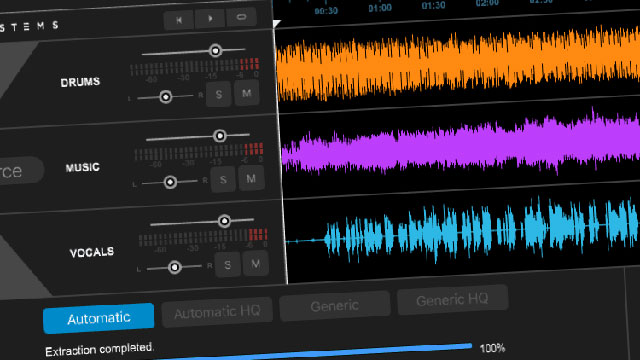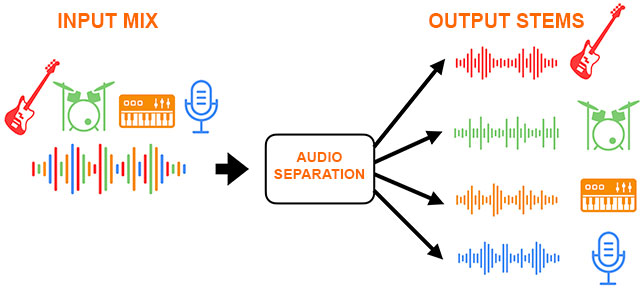 Audio stem separation is essential to modern music production, film and video game post-production and live sound reinforcement. It involves separating individual elements of an audio mix into individual stems, which can be manipulated and processed separately. The ability to separate the elements of a mix opens up new possibilities for audio production and post-production, allowing for greater flexibility and control over the final product.
Audio stem separation is essential to modern music production, film and video game post-production and live sound reinforcement. It involves separating individual elements of an audio mix into individual stems, which can be manipulated and processed separately. The ability to separate the elements of a mix opens up new possibilities for audio production and post-production, allowing for greater flexibility and control over the final product.
Click here to try our free online Audio Stem Separator.
This article will delve into audio stem separation, exploring its basic concepts, advantages and disadvantages, applications, techniques and best practices. Whether you're a seasoned audio professional or just starting in the field, this article will provide a comprehensive overview of everything you need to know about audio stem separation.
At its core, audio stem separation is about unlocking the full potential of an audio mix. By breaking down a mix into its separate elements, audio professionals can fine-tune each stem to create a final product that is perfectly balanced and polished. Whether working on a music production, film or video game post-production, or live sound reinforcement, understanding the basics of audio stem separation is critical to creating high-quality audio that meets your vision and goals.
In the following sections, we'll take a closer look at the basics of audio stem separation, including what audio stems are and why they are used, how it works, and the key considerations involved. We'll also explore the advantages and disadvantages of audio stem separation and its applications in music production and recording, film and video game post-production and live sound reinforcement. Finally, we'll examine the techniques used for audio stem separation, including blind source separation and deep learning techniques and provide best practices for achieving the best possible results.
So if you're ready to take your audio production skills to the next level, read on to discover more about the art of audio stem separation.
 Audio stems refer to a mixed audio track's individual components or elements. They can be considered separate, distinct parts of a mix, such as the drums, bass, guitar and vocals. The purpose of creating audio stems is to allow audio professionals greater flexibility and control over the individual elements of a mix during the production and post-production stages.
Audio stems refer to a mixed audio track's individual components or elements. They can be considered separate, distinct parts of a mix, such as the drums, bass, guitar and vocals. The purpose of creating audio stems is to allow audio professionals greater flexibility and control over the individual elements of a mix during the production and post-production stages.
By separating a mixed audio track into its individual stems, audio professionals can apply specific processing and effects to each stem, such as equalization, compression and reverb. This allows for a finer degree of control over the sound of each stem and the overall mix, resulting in a more polished and well-balanced final product.
Audio stem separation can be accomplished through a variety of techniques, with the most common being source separation techniques. Source separation techniques involve using algorithms to analyze an audio mix and determine the location of each individual source or stem within the mix. Once the sources have been separated, they can be processed and manipulated individually.
The most common source separation techniques include blind source separation, based on mathematical techniques such as independent component analysis and non-negative matrix factorization based on machine learning algorithms. These techniques are designed to separate the sources in an audio mix based on statistical properties and signal relationships.
In recent years, the development of deep learning algorithms has also played a significant role in advancing audio stem separation. Deep learning algorithms, such as convolutional neural networks, have been used to analyze the audio mix and separate the sources based on patterns and characteristics in the data.
Deep learning algorithms can learn and identify patterns in the audio data, allowing for more precise and accurate separation of the sources. Additionally, deep learning algorithms can be trained on specific types of audio data, making them highly adaptable and capable of producing high-quality results in a wide range of audio stem separation scenarios.
The quality of the input audio is a crucial consideration in audio stem separation. The input audio must be of a high enough quality to allow for accurate separation of the sources. Additionally, the input audio must be free of any noticeable noise or artifacts that could affect the accuracy of the separation process.
The number of stems needed for a given audio stem separation project will depend on the project's specific requirements. Some projects may only require a few stems, while others may require many stems to achieve the desired level of control and flexibility.
It's essential to consider the number of stems needed to ensure that the audio stem separation process is efficient and effective. The number of stems needed will also impact the computational resources required for the separation process and the processing time and storage requirements.
Audio stem separation is a powerful technique that offers numerous benefits to those involved in music production, mixing and mastering. Here are a few key advantages of audio stem separation.
One of the most significant advantages of audio stem separation is the increased flexibility it provides in post-production. With stems separated, engineers and producers have much greater control over each specific element in the mix, making it easier to tweak levels, add effects, or make other changes as needed. This increased control can lead to better-sounding mixes and help save time and effort in post-production.
Separating the different elements of a mix into individual stems makes it much easier to control each element individually. This can be especially useful for making precise changes to specific elements, such as adjusting the volume of a background vocal or tweaking the tone of a guitar solo.
Another advantage of audio stem separation is the ease with which it enables editing and remixing. With the stems separated, it's much easier to experiment with different arrangements and make more dramatic changes to the mix if desired. This can be a great way to explore new creative avenues and try different approaches to a mix.
Despite its many benefits, audio stem separation is not without its disadvantages. Here are a few key considerations.
One of the main disadvantages of audio stem separation is that it can be time-consuming and effort-intensive. Depending on the complexity of the mix, separating the stems may require a significant amount of work. The process can be particularly time-consuming if multiple passes are needed to achieve the desired results.
Another potential disadvantage of audio stem separation is the possibility of introducing noise or other artifacts into the mix. This can happen if the separation process is not carried out carefully and high-quality equipment is not used. Separating stems can sometimes lead to a loss of cohesion in the mix and result in a less natural sound.
Overall, audio stem separation is a powerful technique that benefits those involved in music production. However, it's essential to consider the disadvantages and weigh the pros and cons carefully before embarking on a stem separation project. With careful planning, attention to detail and a focus on quality, audio stem separation can be a valuable tool for music production professionals.
 Music production and recording are critical areas where audio stem separation has significantly impacted. Separating the various elements of an audio mix into individual stems provides a new level of control and flexibility during the mixing and mastering stages.
Music production and recording are critical areas where audio stem separation has significantly impacted. Separating the various elements of an audio mix into individual stems provides a new level of control and flexibility during the mixing and mastering stages.
Mixing and mastering are crucial stages in the music production process, where the various elements of a track are blended to create the final mix. Audio stem separation makes it much easier to adjust individual elements of the mix without affecting other elements. This allows for greater precision and control in the mixing process, leading to higher-quality audio recordings.
Remixing and re-sampling are also areas where audio stem separation can be helpful. With individual stems for each element of the mix, reworking the audio in new and creative ways becomes much easier. This can be especially useful in electronic music production, where stems are the building blocks for new tracks and remixes.
Film and video game post-production is another area where audio stem separation has become increasingly popular. The ability to separate the various elements of an audio mix into individual stems provides greater control and flexibility during the sound design and post-production stages.
Sound design is a crucial aspect of film and video game post-production, and audio stem separation can make it much easier to achieve the desired results. By separating the various elements of an audio mix into individual stems, sound designers have greater control over each element, allowing them to make precise adjustments and create genuinely immersive soundscapes.
Dialogue and sound effects separation are critical applications of audio stem separation in film and video game post-production. By separating the dialogue and sound effects into individual stems, sound designers can adjust the levels and balance of each element with greater precision, leading to a more polished and professional final mix.
Live sound reinforcement is another area where audio stem separation has become increasingly popular. The ability to separate the various elements of a live sound mix into individual stems provides greater control and flexibility during the monitor and front-of-house mixing stages.
Monitor mixing is a crucial aspect of live sound reinforcement, and audio stem separation can make it much easier to achieve the desired results. By separating the various elements of a live sound mix into individual stems, sound engineers have greater control over each element, allowing them to make precise adjustments to the monitor mix and ensure that the performers can hear themselves clearly.
Front-of-house mixing is also an area where audio stem separation can be helpful. By separating the various elements of a live sound mix into individual stems, sound engineers have greater control over each element, making precise adjustments to the overall mix and ensuring that the audience hears the best possible sound.
 Blind source separation (BSS) is a set of techniques to separate audio signals from mixtures of sources. BSS is based on the assumption that the sources are statistically independent, meaning their signals are not correlated. Two main techniques used in BSS for audio stem separation are independent component analysis (ICA) and non-negative matrix factorization (NMF).
Blind source separation (BSS) is a set of techniques to separate audio signals from mixtures of sources. BSS is based on the assumption that the sources are statistically independent, meaning their signals are not correlated. Two main techniques used in BSS for audio stem separation are independent component analysis (ICA) and non-negative matrix factorization (NMF).
ICA is a statistical technique that separates independent signals from a mixture by finding the independent components that describe the data. The idea behind ICA is to find the linear combinations of the mixed signals that are as independent as possible. ICA works by maximizing the non-Gaussianity of the source signals. The output of ICA is a set of independent sources that can be used for audio stem separation.
NMF is a factorization technique that separates a non-negative matrix into two non-negative matrices. In audio stem separation, NMF separates a mixed audio signal into its constituent sources. NMF assumes that a non-negative matrix represents each source signal and that the mixed signal is the sum of these matrices. NMF aims to find the matrices that best approximate the mixed signal.
Deep learning is a type of machine learning that uses artificial neural networks to model complex relationships between inputs and outputs. Deep learning techniques are used in audio stem separation to separate audio signals into their constituent sources. Two types of deep learning techniques are used for audio stem separation: convolutional neural networks (CNNs) and recurrent neural networks (RNNs).
CNNs are deep learning algorithms commonly used for image and audio processing. In audio stem separation, CNNs extract high-level features from the audio signal, such as melody and rhythm. The extracted features then separate the audio signal into its constituent sources.
RNNs are deep learning algorithms well-suited for processing sequential data, such as audio signals. In audio stem separation, RNNs separate the audio signal into its constituent sources by learning the temporal dependencies between them. RNNs are often combined with other deep learning techniques, such as CNNs, to improve the performance of the audio stem separation.
 One of the critical considerations regarding audio stem separation is the quality of the input audio. It's crucial to ensure that the audio being processed for separation is high-quality and free from noise and other distortions. This will ensure that the output stems are also high quality, allowing for greater flexibility in post-production and easier editing and remixing.
One of the critical considerations regarding audio stem separation is the quality of the input audio. It's crucial to ensure that the audio being processed for separation is high-quality and free from noise and other distortions. This will ensure that the output stems are also high quality, allowing for greater flexibility in post-production and easier editing and remixing.
It's essential to use proper monitoring equipment to achieve the best results from audio stem separation. This can include studio-quality headphones or speakers, allowing you to accurately assess the quality of the audio being processed and the separation results.
When working with audio stem separation, adhering to industry standards for file formats and resolutions is essential. This can help ensure compatibility with other equipment and software and preserve the quality of the audio as it's processed.
Finally, it's vital to carefully evaluate the output stems from audio stem separation to ensure they are of high quality and meet the desired specifications. This can involve listening to the stems in isolation and evaluating them in the context of the final mix. By carefully considering the output stems, you can ensure that the audio stem separation process has been successful and that you can achieve the desired results.
As we've seen, audio stem separation is a process of separating audio tracks into individual elements for improved flexibility in post-production, better control over individual elements in a mix and ease of editing and remixing. Audio stem separation has several advantages, such as improved flexibility and control, but also disadvantages, such as increased time and effort and the possibility of introducing noise or artifacts.
There are several techniques for audio stem separation, including blind source separation techniques such as independent component analysis (ICA) and non-negative matrix factorization (NMF) and deep learning techniques such as convolutional neural networks (CNNs) and recurrent neural networks (RNNs). The best practices for audio stem separation include the importance of high-quality input audio, proper monitoring equipment, adhering to industry standards for file formats and resolutions, and careful evaluation of output stems.
Audio stem separation is a rapidly developing field, with new techniques and algorithms being constantly developed. The future of audio stem separation will likely see the continued advancement of deep learning techniques and new techniques for improved separation accuracy and efficiency.
In conclusion, audio stem separation is crucial for music production, film and video game post-production and live sound reinforcement. By understanding the basics of audio stem separation, the advantages and disadvantages of the process, the various applications and techniques and the best practices, it's possible to achieve high-quality audio stem separation and take full advantage of its benefits. Whether you're a professional audio engineer or a hobbyist, it's worth investing the time and effort to learn about audio stem separation and use its benefits in your work.